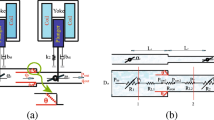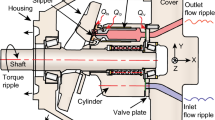Abstract
No-moving-part (NMP) valves, such as Tesla valves, are engineered fluid channels whose flow resistance depends on the flow direction. They have no moving parts and do not deform, but rely on inertial forces of the fluid to preferentially allow flow in one direction while strongly inhibiting flow in the reverse direction. NMP valves have significant advantages over active valves in terms of their reliability and easy manufacturability. Several previous studies have explored optimum designs of NMP valves, and the most widely used indicator of NMP valve performance is diodicity, defined as the ratio of the pressure drop of reverse flow to that of the forward flow. However, higher diodicity does not necessarily imply a lower pressure drop for the forward flow, and if this pressure drop is too high, significant pumping power is required, which makes the NMP valve inefficient for use in pumping applications. Therefore, for the design NMP valves, treating the forward and reverse flow pressure drops independently in a multiobjective formulation is preferable to optimization of the diodicity alone. In this paper, we propose a bi-objective topology optimization method for an optimum design of an NMP valve. One objective function is to minimize the pressure drop in the forward flow, and the other is to maximize the pressure drop in the reverse flow. A numerical example is provided to illustrate the effectiveness of the proposed method.
















Similar content being viewed by others
References
Bendsøe MP, Kikuchi N (1988) Generating optimal topologies in structural design using a homogenization method. Comput Methods Appl Mech Eng 71(2):197–224
Borrvall T, Petersson J (2003) Topology optimization of fluids in Stokes flow. Int J Numer Methods Fluids 41(1):77–107
Cai Z, Wang Y (2006) A multiobjective optimization-based evolutionary algorithm for constrained optimization. IEEE Trans Evol Comput 10(6):658–675
Cardillo A, Cascini G, Frillici FS, Rotini F (2013) Multi-objective topology optimization through GA-based hybridization of partial solutions. Eng Comput 29(3):287–306
COMSOL AB (2013) COMSOL Multiphysics Reference Manual (Version 4.4)
Das I, Dennis JE (1998) Normal-boundary intersection: a new method for generating the Pareto surface in nonlinear multicriteria optimization problems. SIAM J. Optim. 8(3):631–657
Deb K, Pratap A, Agarwal S, Meyarivan T (2002) A fast and elitist multiobjective genetic algorithm: NSGA-II. IEEE Trans Evol Comput 6(2):182–197
Deng Y, Liu Z, Zhang P, Wu Y, Korvink JG (2010) Optimization of no-moving part fluidic resistance microvalves with low Reynolds number. In: 2010 IEEE 23rd International conference on micro electro mechanical systems (MEMS). IEEE, pp 67–70
Deng Y, Liu Z, Wu Y (2013) Topology optimization of steady and unsteady incompressible Navier–Stokes flows driven by body forces. Struct Multidiscip Optim 47(4):555–570
Fan S K S, Chang J M, Chuang Y C (2015) A new multi-objective particle swarm optimizer using empirical movement and diversified search strategies. Eng Optim 47(6):750–770
Fliege J, Svaiter B F (2000) Steepest descent methods for multicriteria optimization. Math Methods Oper Res 51(3):479–494
Fliege J, Drummond L G, Svaiter B F (2009) Newton’s method for multiobjective optimization. SIAM J Optim 20(2):602–626
Forster F K, Bardell R L, Afromowitz M A, Sharma N R, Blanchard A (1995) Design, fabrication and testing of fixed-valve micro-pumps. ASME-PUBLICATIONS-FED 234:39–44
Gamboa A R, Morris C J, Forster F K (2005) Improvements in fixed-valve micropump performance through shape optimization of valves. J Fluids Eng 127(2):339–346
Geoffrion A M (1968) Proper efficiency and the theory of vector maximization. J Math Anal Appl 22(3):618–630
Gersborg-Hansen A, Sigmund O, Haber R B (2005) Topology optimization of channel flow problems. Struct Multidiscip Optim 30(3):181–192
Haimes Y Y, Lasdon L S, Wismer D A (1971) On a bicriterion formulation of the problems of integrated system identification and system optimization. IEEE Trans Syst Man Cybern 1(3):296–297
Izui K, Yamada T, Nishiwaki S, Tanaka K (2015) Multiobjective optimization using an aggregative gradient-based method. Struct Multidiscip Optim 51(1):173–182
Jenkins N, Maute K (2015) Level set topology optimization of stationary fluid-structure interaction problems. Struct Multidiscip Optim 52(1):179–195
Kawamoto A, Matsumori T, Yamasaki S, Nomura T, Kondoh T, Nishiwaki S (2011) Heaviside projection based topology optimization by a PDE-filtered scalar function. Struct Multidiscip Optim 44(1):19–24
Lin S, Zhao L, Guest JK, Weihs TP, Liu Z (2015) Topology optimization of fixed-geometry fluid diodes. J Mech Des 137(8): 081402
Messac A, Ismail-Yahaya A, Mattson CA (2003) The normalized normal constraint method for generating the Pareto frontier. Struct Multidiscip Optim 25(2):86–98
Morganti E, Pignatel G (2005) Microfluidics for the treatment of the hydrocephalus. In: Proceedings of international conference on sensing technology. Palmerston North
Nabavi M (2009) Steady and unsteady flow analysis in microdiffusers and micropumps: a critical review. Microfluid Nanofluid 7(5):599–619
Nishiwaki S, Frecker M I, Min S, Kikuchi N (1998) Topology optimization of compliant mechanisms using the homogenization method. Int J Numer Methods Eng 42:535–559
Obayashi S, Sasaki D (2002) Self-organizing map of Pareto solutions obtained from multiobjective supersonic wing design. AIAA Paper 991:2002
Oyama A, Nonomura T, Fujii K (2010) Data mining of Pareto-optimal transonic airfoil shapes using proper orthogonal decomposition. J Aircraft 47(5):1756–1762
Sato Y, Izui K, Yamada T, Nishiwaki S (2016) Gradient-based multiobjective optimization using a distance constraint technique and point replacement. Eng Optim 48(7):1226–1250
Sigmund O (2007) Morphology-based black and white filters for topology optimization. Struct Multidiscip Optim 33(4-5):401– 424
Suzuki K, Kikuchi N (1991) A homogenization method for shape and topology optimization. Comput Methods Appl Mech Eng 93(3):291–318
Svanberg K (1987) The method of moving asymptotes—a new method for structural optimization. Int J Numer Methods Eng 24(2):359–373
Tai K, Prasad J (2007) Target-matching test problem for multiobjective topology optimization using genetic algorithms. Struct Multidiscip Optim 34(4):333–345
Truong T, Nguyen N (2003) Simulation and optimization of Tesla valves. In: 2003 Nanotech-Nanotechnology conference and trade show, pp 178–181
Whitaker S (1986) Flow in porous media I: a theoretical derivation of Darcy’s law. Trans. Porous Media 1 (1):3–25
Yaji K, Yamada T, Kubo S, Izui K, Nishiwaki S (2015) A topology optimization method for a coupled thermal–fluid problem using level set boundary expressions. Int J Heat Mass Transfer 81:878–888
Zadeh L (1963) OptiMality and non-scalar-valued performance criteria. IEEE Trans Autom Control 8(1):59–60
Zhang B, Liu X (2015) Topology optimization study of arterial bypass configurations using the level set method. Struct Multidiscip Optim 51(3):773–798
Zhang B, Liu X, Sun J (2015) Topology optimization design of non-Newtonian roller-type viscous micropumps. Struct Multidiscip Optim 1–16
Zhao S Z, Suganthan P (2011) Two-lbests based multi-objective particle swarm optimizer. Eng Optim 43 (1):1–17
Zhou S, Li Q (2008) A variational level set method for the topology optimization of steady-state Navier–Stokes flow. J Comput Phys 227(24):10,178–10,195
Author information
Authors and Affiliations
Corresponding author
Rights and permissions
About this article
Cite this article
Sato, Y., Yaji, K., Izui, K. et al. Topology optimization of a no-moving-part valve incorporating Pareto frontier exploration. Struct Multidisc Optim 56, 839–851 (2017). https://doi.org/10.1007/s00158-017-1690-8
Received:
Revised:
Accepted:
Published:
Issue Date:
DOI: https://doi.org/10.1007/s00158-017-1690-8




